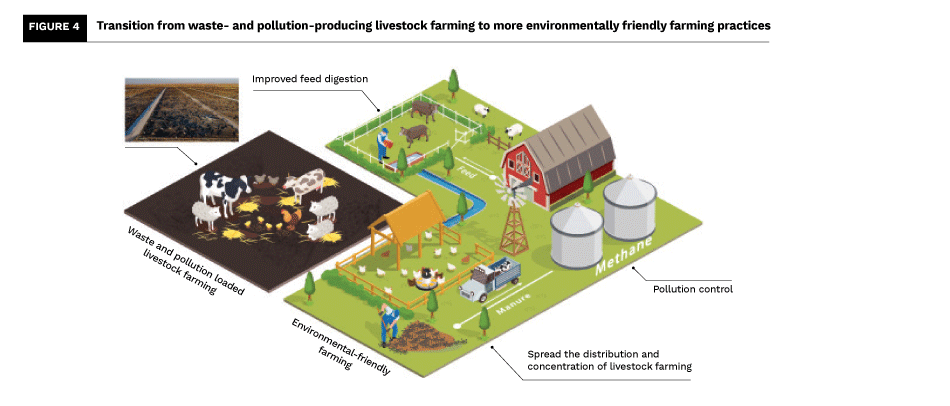By Lotte Maria Reuter, Charlotte von der Ohe, and Michael Palocz-Andresen
Current global food production causes approximately a quarter of greenhouse gas (GHG) emissions, with animal products, particularly meat, making up a significant amount 1. In addition, the production process of these meat products requires large amounts of resources, such as agricultural land and fresh water, and can lead to environmental and health risks. After depicting current global meat consumption and the associated risks, this paper aims to provide an overview of possible ways to effectively reduce GHG emissions and related harm caused by the production and consumption of animal products, specifically meat. The measures target different stages and actors along the value chain.
The production of meat is a major emitter of greenhouse gases, consumer of resources, and source of risk to the environment and human health. The good news is that – by pulling together – we can do something about it.
Introduction
In order to accommodate high levels of consumption, livestock farming requires large amounts of resources, and causes emissions as well as air and water pollution. The dietary choice of animal products is thus a major contributor to global warming and environmental degradation, and poses health risks. Recently, additional stress is being put on the food system by rising energy and subsequently fertiliser prices and a shortage in the supply of resources following Russia’s attacks on Ukraine. Hence, reducing the consumption of animal products, especially meat, and making its production more sustainable are important steps for the protection of the environment, in the fight against anthropogenic climate change, and in order to ensure resilience and safety in the food supply. The process, as well as the pathway towards change, is depicted in figure 1.

International comparison
Global meat consumption has increased significantly in recent decades and, with it, meat production, going from 232.8 million tonnes in 2000 to 337.2 million tonnes in 2020, a 45 per cent increase 2. This is due to economic and population growth (figure 2).
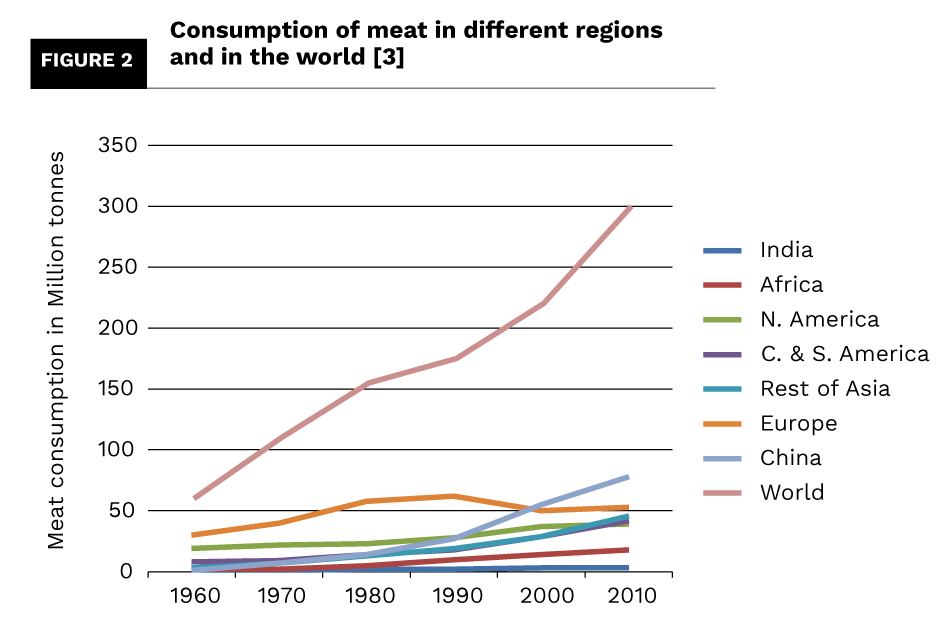
While the increase in meat consumption in developing countries is predicted to be about five times higher than that in developed countries over the next 10 years (figure 3), consumption levels in industrialised countries are often close to saturation, due to meat being valued less in accordance with its cheap methods of production 4. However, it is noteworthy that consumption today is increasing at a slower rate than 10 years ago 5, in some cases even decreasing slightly in recent years due to concerns about health, animal welfare, and the environment. Nevertheless, per capita meat consumption in developed countries remains significantly higher compared to that in developing countries, resulting in 83 per cent of the average European’s food emissions being caused by meat, eggs, and dairy products 1.
The overall increase in production and consumption over the past 50 years includes all major meat types, yet not to the same extent, as depicted in figure 3. The share of pork and, particularly, poultry in total consumption is increasing, while that of lamb and beef is decreasing 4 (table 1).
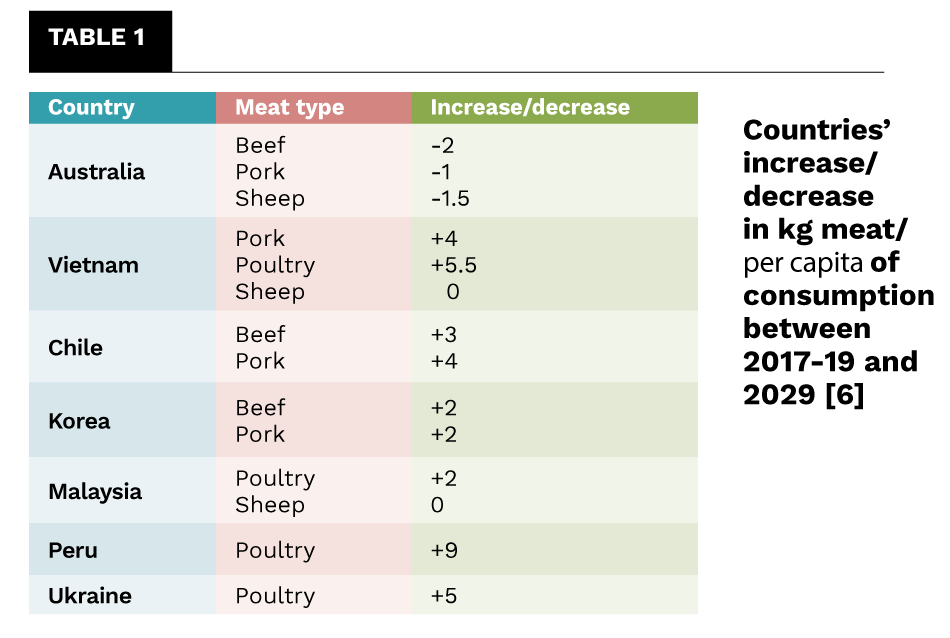 Greenhouse gas emissions and additional risks
Greenhouse gas emissions and additional risks
The global climate is warming steadily and new record temperatures are continually being registered. This climate crisis has a variety of consequences for the environment and humankind, ranging from water and food scarcity over melting glaciers and ice sheets, rising sea levels, and natural disasters to social conflicts arising from the direct effects of climate change, and many more 7.
This anthropogenic change in the global climate finds its origin in industrialisation and is caused by the increased emission of greenhouse gases, consisting of carbon dioxide (CO2), methane (CH4), nitrous oxide (N2O), hydrofluorocarbons (HFC), perfluorocarbons (PFC), and sulphur hexafluoride (SF6). Of the five main causes of the increase in emissions identified by the European Commission, three can be directly or indirectly linked to meat consumption and factory farming, namely deforestation, increased livestock farming, and the use of fertilisers 8. The 5th Assessment Report of the Intergovernmental Panel on Climate Change (IPCC) concludes that approximately 10-12 GtCO2eq/year are emitted by the “agriculture, forestry and other land use” (AFOLU) sector, accounting for just under a quarter of anthropogenic greenhouse gas emissions 9.
 The total emissions generated in the livestock production chain are composed of several categories (table 2). Animal feed production accounts for almost 50 per cent of these emissions. With almost 40 per cent, the gases that occur during digestion (enteric gases) are in second place. Just under 10 per cent are generated by manure management, meaning the management of the animal wastes. The remaining 5 per cent are caused by direct and indirect energy use or arise after production 10.Focusing on the enteric emissions, the largest share can be attributed to cows, causing about 75 per cent, while other animal species such as sheep or goats cause 7 per cent or less (table 3). As a digestive by-product, ruminants produce enteric methane, which is the most common greenhouse gas from agriculture 11. Over a 20 year period, it is 84-6 times more damaging to the climate than CO2 [12].
The total emissions generated in the livestock production chain are composed of several categories (table 2). Animal feed production accounts for almost 50 per cent of these emissions. With almost 40 per cent, the gases that occur during digestion (enteric gases) are in second place. Just under 10 per cent are generated by manure management, meaning the management of the animal wastes. The remaining 5 per cent are caused by direct and indirect energy use or arise after production 10.Focusing on the enteric emissions, the largest share can be attributed to cows, causing about 75 per cent, while other animal species such as sheep or goats cause 7 per cent or less (table 3). As a digestive by-product, ruminants produce enteric methane, which is the most common greenhouse gas from agriculture 11. Over a 20 year period, it is 84-6 times more damaging to the climate than CO2 [12].
 In addition to generating emissions, meat production is associated with high levels of land use. While the exact amount of land needed for food production depends on regions and the chosen production system, approximations can be made. Thus the production of 100 g of protein from beef needs an average of 104 m² of land; for the same amount of protein, an average area of only 6.4 m² is needed for chicken, 5.7 m2 for beans and only 2.1 m2 for tofu. Hence, animal products require more land than plant-based alternatives 13. This strongly relates to the animal feed; more than a third of all crops worldwide are cultivated for livestock feed. The high demand for land leads to deforestation, further contributing to climate change and endangering biodiversity. Globally increasing amounts of pesticides are used for the production of feed and during livestock farming. This not only endangers ecosystems and the health of workers but also, together with the high level of antibiotics use, leads to increased antibiotic resistance. 5,14.
In addition to generating emissions, meat production is associated with high levels of land use. While the exact amount of land needed for food production depends on regions and the chosen production system, approximations can be made. Thus the production of 100 g of protein from beef needs an average of 104 m² of land; for the same amount of protein, an average area of only 6.4 m² is needed for chicken, 5.7 m2 for beans and only 2.1 m2 for tofu. Hence, animal products require more land than plant-based alternatives 13. This strongly relates to the animal feed; more than a third of all crops worldwide are cultivated for livestock feed. The high demand for land leads to deforestation, further contributing to climate change and endangering biodiversity. Globally increasing amounts of pesticides are used for the production of feed and during livestock farming. This not only endangers ecosystems and the health of workers but also, together with the high level of antibiotics use, leads to increased antibiotic resistance. 5,14.
Moreover, large amounts of water are required for meat production. The water footprint of food is a useful indicator of its environmental impact. The water footprint per calorie of beef is 20 times greater than that of cereals. Just as with land use and GHG emissions, water requirements vary significantly by animal species, livestock management, and production system. The production of one kilogram of chicken requires an average of 4,325 l of water, whereas that of beef requires an average of 15,415 l of water. Most of the water needed in the production of meat is attributable to feed production 5.
 Furthermore, the issue of manure arises. With the increasing amount of livestock being held, manure has reached a quantity that exceeds local capacities and can no longer be completely used as a valuable agricultural resource. Instead, it leads to the pollution of ground and surface water and an increase in particulate matter and other air pollutants, which then can lead to acid rain, loss of soil fertility, and health issues, while also contributing to climate change. Overall, there is a food safety risk and increased emergence of pathogens and zoonotic diseases, to name only a few 14. These consequences can combine to conflict with the UN SDGs – most prominently Goal 6 (clean water and sanitation) and Goal 3 (good health and well-being), while the process as a whole acts contrary to Goal 12 (responsible production and consumption) and Goal 13 (climate action) 15.
Furthermore, the issue of manure arises. With the increasing amount of livestock being held, manure has reached a quantity that exceeds local capacities and can no longer be completely used as a valuable agricultural resource. Instead, it leads to the pollution of ground and surface water and an increase in particulate matter and other air pollutants, which then can lead to acid rain, loss of soil fertility, and health issues, while also contributing to climate change. Overall, there is a food safety risk and increased emergence of pathogens and zoonotic diseases, to name only a few 14. These consequences can combine to conflict with the UN SDGs – most prominently Goal 6 (clean water and sanitation) and Goal 3 (good health and well-being), while the process as a whole acts contrary to Goal 12 (responsible production and consumption) and Goal 13 (climate action) 15.
A last major issue is food waste. This accounts for about 6 per cent of global greenhouse gas emissions, as about a quarter of food is thrown away, spoiled, or spilled in supply chains, at retail or restaurant level or in private households. This is due to poor storage and handling techniques, lack of refrigeration, spoilage, and misconceptions regarding the shelf life 1.
Solutions
In order to limit the harmful impact of meat production on the environment and achieve a more balanced practice of livestock farming, different paths can be taken (figure 4). While some measures target production, others are based on changing consumer behaviour, and still others are aimed at changing legal requirements and policies.
Lifestyle change
There are various approaches that start with consumer behaviour, including switching to less climate-impacting species, reducing the consumption of animal products, replacing them with alternatives, and reducing food waste.
In many countries, consumers eat more meat and dairy products than recommended by the government. In Germany, an average of 600 g of meat per person per week would be eaten if the recommendations of the German Nutrition Society were followed. This corresponds to a 48 per cent reduction compared to the average consumption in 2017, and would reduce greenhouse gas emissions by 7.37 million tonnes per year 16.
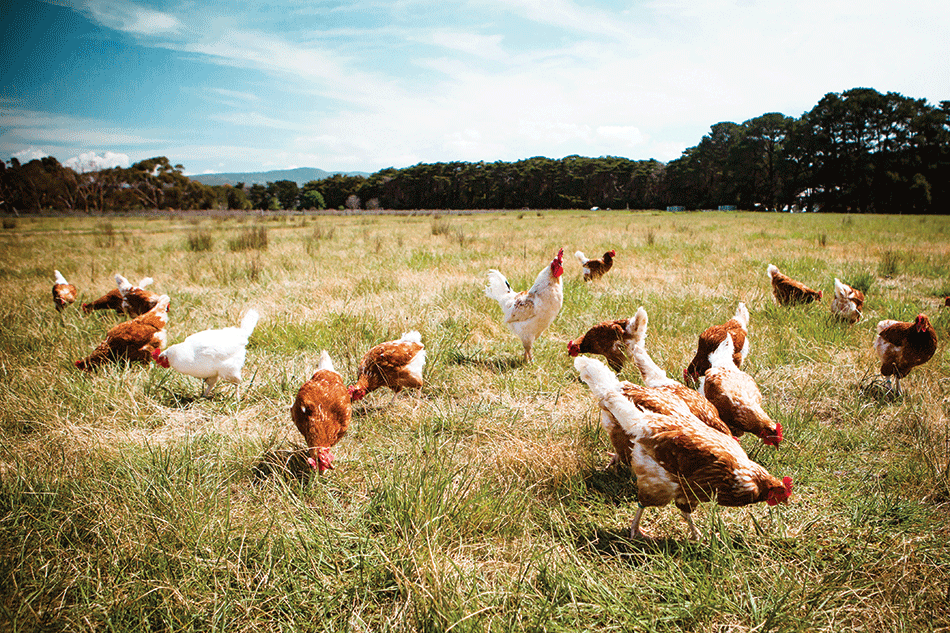 Another way to reduce the demand for meat is to reduce food waste. Goal 12 of the SDGs is dedicated to sustainable consumption and production patterns, including halving global food waste per capita at retail and consumer level. The majority of food waste in Germany is generated in private households, at 52 per cent (6.14 million tonnes), which corresponds to about 75 kg per capita in 2015. About half of this waste could be avoided 17. Consumers could drastically reduce meat waste by switching to a strict zero-waste strategy to reduce the impact of meat production on the climate. In addition, consumers could be encouraged to eat more of the offal of animals by increasing its value.
Another way to reduce the demand for meat is to reduce food waste. Goal 12 of the SDGs is dedicated to sustainable consumption and production patterns, including halving global food waste per capita at retail and consumer level. The majority of food waste in Germany is generated in private households, at 52 per cent (6.14 million tonnes), which corresponds to about 75 kg per capita in 2015. About half of this waste could be avoided 17. Consumers could drastically reduce meat waste by switching to a strict zero-waste strategy to reduce the impact of meat production on the climate. In addition, consumers could be encouraged to eat more of the offal of animals by increasing its value.
Alternatives
Conventional meat can be completely or at least partially replaced by insects, in-vitro meat and plant-based alternatives. However, these differ significantly from one another in their efficiency in reducing the climate-damaging emissions of meat.
Currently, there is a tendency for more poultry and pork to be consumed, while beef and lamb consumption are decreasing. If beef is replaced by poultry, this already has a positive effect on the carbon footprint of an omnivorous diet, as poultry products are better for the environment, partly because of the smaller amount of agricultural land needed 18. If an average German household were to replace its calories from red meat and dairy products with chicken, fish, or eggs on just one day per week, it would save 0.3 tCO2eq. The positive effect would be even stronger if beef and dairy products were replaced by plant-based alternatives, which would save 0.46 tCO2eq 16.

The global sales market for meat substitutes is growing steadily and already amounted to US$4.6 billion in 2017. In Germany, the production of vegetarian and vegan meat substitute products increased by 37 per cent in the first quarter of 2020, i.e. from 14.7 thousand tonnes to about 20 thousand tonnes. However, the sales figures of substitute products are still very low compared to conventional meat. In 2019, the production of meat substitute products on the German market achieved a value of €272.8 million, while the production value of the meat, poultry meat and processed meat categories together amounted to around €40.1 billion 19. In-vitro meat is not yet available on the market, but investor interest in production is increasing.
Edible insects such as mealworms, grasshoppers, and crickets have the potential to become an important source of food for humans. They are high in fat, protein, and micronutrients. However, consumer attitudes towards edible insects may change in the future. Another problem for the establishment of insects on the European market is the European Union’s regulations concerning novel foods and the legal status of insect-based foods, according to which insects may not be processed and must be marketed as a whole 18.
In-vitro meat, also known as lab-based or cultured meat, is produced outside a living animal. “The meat is produced by culturing animal stem cells in a medium that contains nutrients and energy sources required for the division and differentiation of the cells into muscle cells that form into tissue.” 18 The amount of nutrients and energy required can be relatively small, as only muscle tissue is developed, and the development of respiratory, digestive or nervous systems, and skin is not necessary. However, cell and tissue cultures are currently not efficient processes in terms of energy, water, and raw material consumption. Financial, health, and sustainability benefits are also unclear, as research is still in its infancy. Just as with insects, there are consumer barriers to in-vitro meat. The product must have sufficient similarity to farm-animal meat in terms of taste, texture, and appearance to gain high acceptance, and this is still difficult to achieve at the moment 18.
 Plant-based alternatives include tofu and tempeh, which are made from soya, pea- or lupin-based products and seitan, which is made from wheat protein. These can be used to imitate conventional meat. Imitation of meat includes the criteria of smell, taste, texture, appearance, and consistency. Complete imitation is difficult to achieve with plant-based alternatives, but they can have very good nutritional values. Tofu, for example, has a high protein content but is low in fat, so it has a similar protein value to beef for human nutrition. As shown in table 4, soya beans also produce the most protein and energy per unit of farmland compared to conventional meat and the other alternatives studied 18. Another advantage of plant-based alternatives is that they are well accepted. Fifteen per cent see them as a good substitute, and 26 per cent would try them 5.
Plant-based alternatives include tofu and tempeh, which are made from soya, pea- or lupin-based products and seitan, which is made from wheat protein. These can be used to imitate conventional meat. Imitation of meat includes the criteria of smell, taste, texture, appearance, and consistency. Complete imitation is difficult to achieve with plant-based alternatives, but they can have very good nutritional values. Tofu, for example, has a high protein content but is low in fat, so it has a similar protein value to beef for human nutrition. As shown in table 4, soya beans also produce the most protein and energy per unit of farmland compared to conventional meat and the other alternatives studied 18. Another advantage of plant-based alternatives is that they are well accepted. Fifteen per cent see them as a good substitute, and 26 per cent would try them 5.
Technological changes
An alternative approach to combatting rising emissions from livestock farming targets the supplier side. Here, the focus is set on the stage of pre-production, with the overarching goal of reducing as many emissions and harmful environmental impacts as possible, while still continuing production without compromising sales 14.
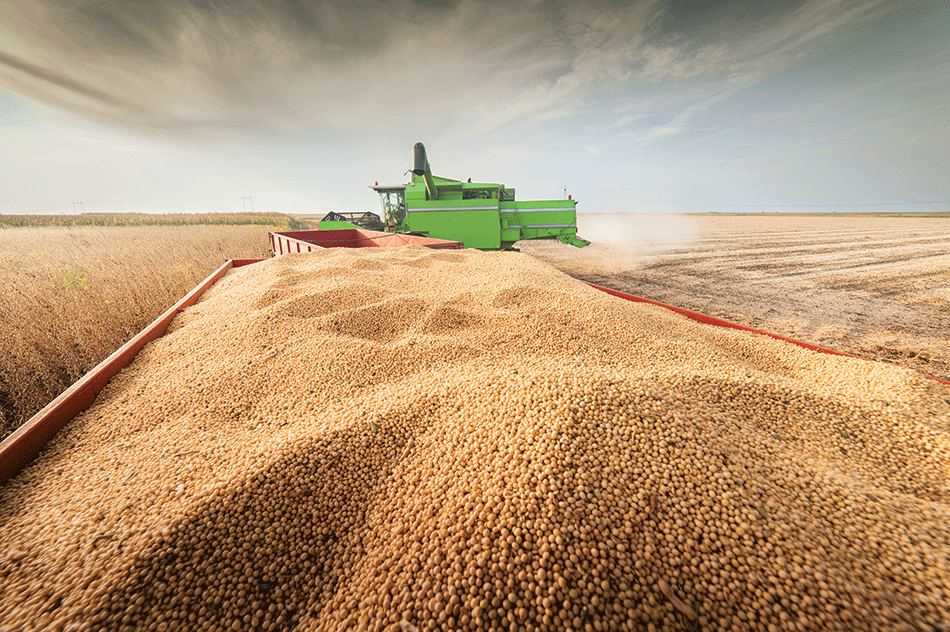 One strategy to be considered is increasing the efficiency of existing systems, focusing specifically on breeding, feed, and sanitation. In breeding, the aim is to increase the animals’ productivity, meaning a young age at slaughter, thus fewer days of feeding but still with a high output. This is influenced by animal genetics and hormonal growth promoters. In the area of feed, a distinction should be made between additives and vaccinations on the one hand and improved feed digestion on the other. In the first approach, supplements are added to the feed, such as inhibitors, including algae or 3-nitrooxypropanol (3-NOP), which can lead to a methane reduction of up to 40 per cent. Other approaches include vaccines against methanogens, plant bioactive compounds, dietary lipids from vegetables and animal oils, and electron receptors such as nitrates. For improved digestion, feed quality and management are enhanced, concentrates are added, and feed gaps are filled. In addition, feeding is done with precision while being analysed 14, 20.
One strategy to be considered is increasing the efficiency of existing systems, focusing specifically on breeding, feed, and sanitation. In breeding, the aim is to increase the animals’ productivity, meaning a young age at slaughter, thus fewer days of feeding but still with a high output. This is influenced by animal genetics and hormonal growth promoters. In the area of feed, a distinction should be made between additives and vaccinations on the one hand and improved feed digestion on the other. In the first approach, supplements are added to the feed, such as inhibitors, including algae or 3-nitrooxypropanol (3-NOP), which can lead to a methane reduction of up to 40 per cent. Other approaches include vaccines against methanogens, plant bioactive compounds, dietary lipids from vegetables and animal oils, and electron receptors such as nitrates. For improved digestion, feed quality and management are enhanced, concentrates are added, and feed gaps are filled. In addition, feeding is done with precision while being analysed 14, 20.
Another strategy targets procedures and technologies for pollution control, as well as less-damaging processes. This includes anaerobic digestion, resulting in methane capture and utilisation. Other possible approaches are the recovery and sale of ammonia as fertiliser, the construction of animal quarters so that less antibiotics are needed to guard against disease outbreaks and, finally, covering of anaerobic lagoons 14.
Furthermore, there are other individual areas in which emissions occur, as explained in the previous chapter, which are less prevalent in these three strategies – for example, land use. Here, the mitigation potential lies in restoration, reduced deforestation, and an overall increase in the growth of woody biomass. Moreover, waste streams could be utilised by converting them, so that manure and food waste could be turned into energy, as well as microbial protein and hydrocarbon. This not only prevents emissions but could also serve as another source of income for the farmers. Furthermore, renewable energy could be used along the value chain and the overall energy efficiency could be increased, for example in refrigeration 20.
Many of these approaches still need further development and, even if they have a high technical mitigation potential, the economic mitigation potential is still quite low. Therefore, a combination with other mitigation strategies is needed 20. In addition, it should always be noted that the most efficient mitigation option is the overall reduction of consumption, which not only takes the pressure off the technologies mentioned but is the most promising way for the food sector to counteract climate change.
Political approaches
Governments and politicians are additional relevant actors in the mitigation of emissions and in overcoming the issues arising from meat consumption. Through an appropriate climate policy, which also covers the meat sector, they support consumers and producers in reducing the overall negative effects of production.
In order to promote the use of the technologies and motivate farmers, different measures come into question. For example, by taxing CO2, the industry will look for production options that result in low CO2 emissions. It is also possible to tax the disposal or emissions of manure. Alternatively, a way could be chosen by which farmers are paid, instead of having to pay themselves, such as through purchasing verified emission reductions. Another cost incentive could be that farmers are paid more money for products that do not contain hormones or antibiotics or similar. Further incentives, e.g. in relation to the price of water, could promote actions that have a high resource use efficiency. However, this is risky, as it could also lead to poorer management and a resulting increase in emissions and environmental damage. Furthermore, those incentives in the field of energy that favour a damaging system instead of an environmentally friendly one should be removed.
Governments could also play an active role in reducing consumption. For example, national efforts could be made to raise awareness of the negative consequences of meat consumption, especially among consumers, but also, for instance, among medical professionals. This could be done by improved communication of nutritional guidelines. Furthermore, economic approaches, such as the aforementioned taxes, could also lead to a reduction in meat consumption. In Germany, for example, one approach would be to place meat products in the higher VAT category. Other monetary measures could also be considered to support consumers in choosing a healthy and sustainable diet and in order to make this diet affordable 14.
Financial approaches
Development banks are currently financing large meat companies and thus factory farming with public funds across all continents. These financing decisions do not only enable factory farming, but also all the steps prior to the actual farming and all the consequences that have been mentioned throughout this article that are linked to meat production, i.e. deforestation, emissions, and the pollution of water and soil, affecting especially the local population. In addition, there are social problems related to labour protection, which will be considered in the following chapter. These types of funding are promoted as aiming to make meat production more sustainable and create more jobs, yet the recipients of the investments are the world’s largest meat producers, whose actions are further supported by the money. This behaviour actively conflicts with the sustainable development goals of the UN and endangers small farmers and producers, as well as the entire environment 21.
For socially just meat production and distribution and, at the same time, environmental and climate protection, no more funds should flow into large corporations that produce in detrimental ways, but rather they should be systematically allocated to those who, on the one hand, actually need it and, on the other, have shown willingness to engage in environmental protection and to operate responsibly.
A possible consequence of alternative financing decisions by development banks would be that financial institutions, as well as other actors, would follow this behaviour as an example and act or invest accordingly. Nevertheless, more and more stakeholders are already now emerging, investing specifically in alternative protein sources, and supporting the shift to more sustainable diets.
Social approaches
About one million people work in the European meat industry and their working conditions have been criticised for decades. Thousands of people, usually migrants from Central and Eastern Europe, are precariously employed by subcontractors. In the Netherlands, for one of the largest meat exporters, this figure is estimated to be as high as 90 per cent 22.
Because of public criticism, some countries have tightened regulations on working conditions in recent years. Germany, among others, has banned subcontracting since 1 January 2021, so the legal framework for workers has improved. However, the law contains loopholes for smaller companies, for example. Tougher controls are necessary to guarantee sustainable improvement in working conditions and housing.
Summary
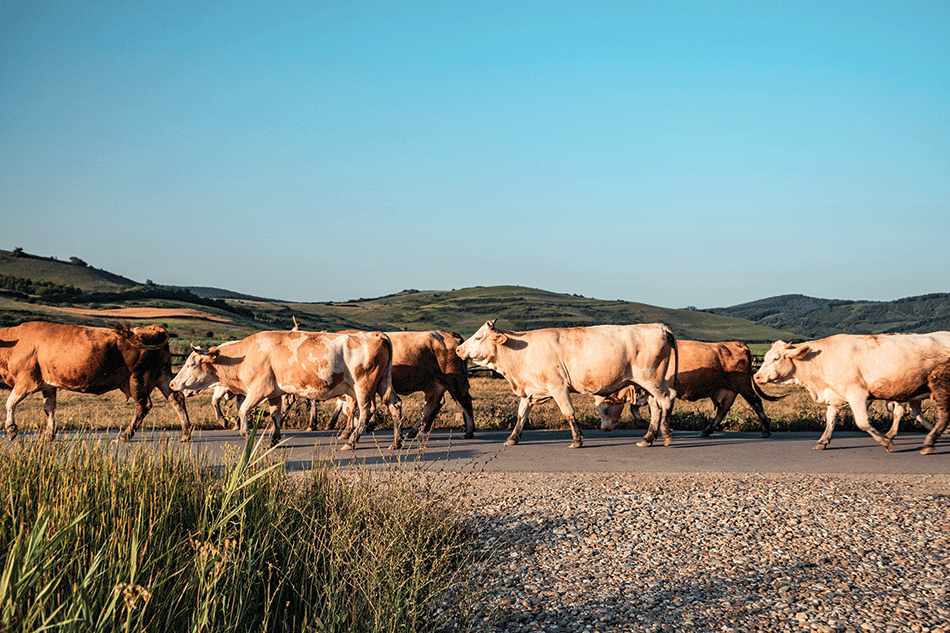
Today’s meat consumption and detrimental production pose a major threat to the environment and a sustainable future. A distinction can be made between the supplier and the demand side. On the supplier side, technologies come into play that aim to guarantee the same output with lower emissions and pollutants, for example by targeting and improving breeding, feeding, and manure management. On the consumer side, the potential is great, as the total demand and thus the resulting damage can be significantly minimised. This requires a change in diet, from reduced to completely halted meat consumption. To facilitate this change, the market for meat substitutes or even insects is growing. In order to support the change and the implementation of solutions for both sides, policy makers can also play an important role by introducing incentives and taxation to promote low-emission production and sustainable and healthy diets that are socially just. Additional changes need to occur in the financing of meat consumption and the way workers in the meat industry are treated. By having all stakeholders working well together and thus combining the aforementioned solution approaches, the damage to the climate and the environment could be minimised and a positive impact could be made jointly.
Outlook
Looking ahead, it is important that action should be taken quickly by all the parties involved, and that solutions that are already available should be implemented in a timely manner. The knowledge and awareness of the problems and ways to overcome them already exist, but they must be further spread through good communication and the way must be facilitated for the parties to act accordingly. Also, this sustainable shift needs to be made socially feasible and even small farms should be able to operate sustainably and receive fair prices for their products.
Acknowledgement
The authors would like to thank Prof. Dr José Ignacio Huertas, director of the Energy and Climate Change Research Group at the TEC de Monterrey Instituto Tecnológico y de Estudios Superiores de Monterrey for years of support in this scientific area.
About the Authors
 Charlotte von der Ohe started her bachelor’s degree with a major in business administration and a minor in economics at Leuphana University Lüneburg in 2020. In addition to her studies, she is involved in the BEM student council and sneep (student network for ethics and economics in practice), a student initiative that promotes business and corporate ethics.
Charlotte von der Ohe started her bachelor’s degree with a major in business administration and a minor in economics at Leuphana University Lüneburg in 2020. In addition to her studies, she is involved in the BEM student council and sneep (student network for ethics and economics in practice), a student initiative that promotes business and corporate ethics.
 Lotte Maria Reuter has studied environmental sciences and law in her bachelor’s degree at Leuphana University Lüneburg since 2019. In her studies, she focuses on international and national environmental law, renewable energies, and the effects of agriculture on the environment. Additionally she worked as a student assistant at the Fachagentur Windenergie an Land and did an internship with the European Commission in Brussels.
Lotte Maria Reuter has studied environmental sciences and law in her bachelor’s degree at Leuphana University Lüneburg since 2019. In her studies, she focuses on international and national environmental law, renewable energies, and the effects of agriculture on the environment. Additionally she worked as a student assistant at the Fachagentur Windenergie an Land and did an internship with the European Commission in Brussels.
 Michael Palocz-Andresen works as a guest professor at the Benemérita Universidad Autónoma de Puebla México. From 2018 to 2022, he was a Herder-professor supported by the DAAD at the TEC de Monterrey. He became a full professor at the University West-Hungary Sopron, a guest professor at the TU Budapest, the Leuphana University Lüneburg, and the Shanghai Jiao Tong University. He is a Humboldt scientist and an instructor of the SAE International in the USA.
Michael Palocz-Andresen works as a guest professor at the Benemérita Universidad Autónoma de Puebla México. From 2018 to 2022, he was a Herder-professor supported by the DAAD at the TEC de Monterrey. He became a full professor at the University West-Hungary Sopron, a guest professor at the TU Budapest, the Leuphana University Lüneburg, and the Shanghai Jiao Tong University. He is a Humboldt scientist and an instructor of the SAE International in the USA.
References
- Ritchie, H. and Roser, M. (2020) Environmental Impacts of Food Production, Our World in Data. Available at: https://ourworldindata.org/environmental-impacts-of-food?country (Accessed: 7 March 2022).
- Statistisches Bundesamt (Destatis) Global animal farming, meat production and meat consumption, 2022. Available at: https://www.destatis.de/EN/Themes/Countries-Regions/International-Statistics/Data-Topic/AgricultureForestryFisheries/livestock_meat.html (Accessed: 27 July 2022).
- FAO, FAOSTAT (2018)
- OECD-FAO (2021) Agricultural Outlook 2021-2030. OECD. doi: 10.1787/19428846-en.
- Chemnitz, C. et al. (2021) Fleischatlas: Daten und Fakten über Tiere als Nahrungsmittel.
- OECD/FAO (2020), Agricultural Outlook 2020-2029, https://doi.org/10.1787/1112c23b-en.
- United Nations (no date) The Climate Crisis – A Race We Can Win. Available at: https://www.un.org/en/un75/climate-crisis-race-we-can-win (Accessed: 12 March 2022).
- European Commission (no date) Causes of climate change. Available at: https://climate.ec.europa.eu/climate-change/causes-climate-change_en (Accessed: 12 March 2022).
- Smith, P. et al. (2014) Assessment Report 5: Agriculture, Forestry and Other Land Use (AFOLU), IPCC.
- Gerber, P. et al. (2013) “Tackling Climate Change Through Livestock: A Global Assessment of Emissions and Mitigation Opportunities”, Food and Agriculture Organisation of the United Nations (FAO). Available at: www.fao.org/publications (Accessed: 12 March 2022).
- Conchedda, G. and Tubiello, F.N. (2020) “Emissions due to agriculture: Global, regional and country trends 2000-2018”, Food and Agriculture Organisation of the United Nations.
- UNECE (no date) Methane Management: the Challenge. Available at: https://unece.org/challenge (Accessed: 12 March 2022).
- Ritchie, H. and Roser, M. (2013) Land Use, Our World in Data. Available at: https://ourworldindata.org/land-use.
- Cassou, E. (2018) Agricultural Pollution: Livestock Wastes, World Bank Group.
- United Nations (no date) The 17 Goals: Sustainable Development. Available at: https://sdgs.un.org/goals (Accessed: 12 March 2022).
- Scheffler, M. and Wiegmann, K. (2019) Quantifizierung von Maßnahmenvorschlägen der deutschen Zivilgesellschaft zu THG – Minderungspotenzialen in der Landwirtschaft bis 2030. Available at: www.oeko.de (Accessed: 28 May 2022).
- Schmidt, T. et al. (2019) Thünen Report 71 Lebensmittelabfälle in Deutschland-Baseline 2015. doi: 10.3220/REP1563519883000.
- Alexander, P. et al. (2017) “Could consumption of insects, cultured meat or imitation meat reduce global agricultural land use?”, Global Food Security. Elsevier B.V., S. 22–32. doi: 10.1016/j.gfs.2017.04.001.
- Statistisches Bundesamt (Destatis) Vegetarische und vegane Lebensmittel: Produktion steigt im 1. Quartal 2020 um 37%, 2020.
- Mbow, C. et al. (2019) Climate Change and Land: Food security, IPCC.
- Hamerschlag, K. and D Cook, C. (2021). To fight the climate crisis, banks must stop financing factory farming. The Guardian. Available at: https://www.theguardian.com/commentisfree/2021/oct/19/climate-crisis-factory-farming-paris-climate-un (Accessed 20 September 2022)
- McSweeney, E. and Young, H. (2021) “Revealed: exploitation of meat plant workers rife across UK and Europe”, The Guardian.




